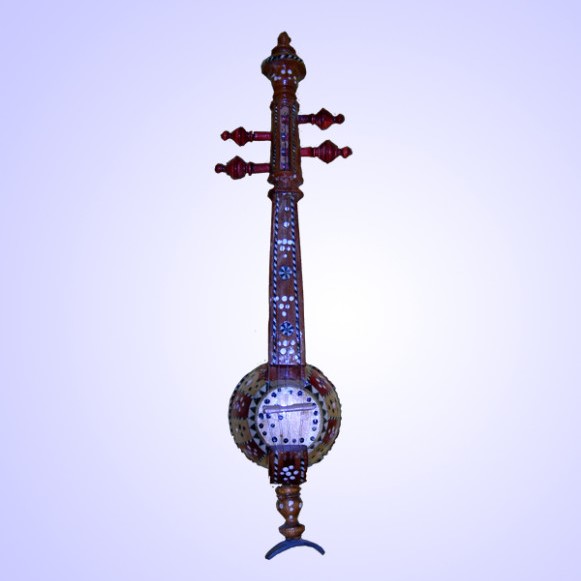Ajax's classification
In the process of spreading, Aijie has been continuously enriched and developed, and formed a variety of different types. Divided by the main strings, there are one string, two strings and three strings Aijie. In terms of regions, there are Doran Ayce and Hami Ayce. In addition to the traditional Aiji, there are also reformed new Aiji and Bass Aiji. Although there are many varieties and different shapes, they are the most commonly used musical instruments in Uyghur folk bands.

Dolangai Czech is popular in Hotan, Shache, Megaiti, Kashgar, Bachu, Avati and Kuqa in southern Xinjiang and Dolang area. There are 1 to 3 main strings.
Dolang one-string Aijie, the main string is tuned to c1, the 8 resonant strings are tuned to g, c1, d1, e1, g1, a1, b1, d2, and the range is from C1 to C3, with a total of two octaves.
Duolang two-string Aijie, the two main strings on the piano are mostly ponytail strings, and some are casing strings or metal strings. They are tuned four degrees apart. On both sides of the middle of the piano, there are 5 steel wires that resonate. string. When playing, place the qin on your lap, and use a ponytail bow to play outside the main string, and the other strings resonate.
Duolang Sanxian Aijie was made by Uyghur folk artists in southern Xinjiang in the 1920s on the basis of two-string Aijie. It uses horsetail strings, casing strings or metal strings. Now it is widely popular in Xinjiang. The 3 main strings are set as d1, g1, and c2 according to the relationship of the fourth degree, and the 10 steel wire resonance strings are set as c, d, e, g, a, c1, d1, e1, g1, a1, and the range is from d1 to d3 , has two octaves.
Hami Aijk
Hami Ai Czech is popular in the Hami area of eastern Xinjiang. It is also called "Hami Huqin" because of its similarity to the Huqin. There are two kinds of drums, wooden and thin iron. The front mouth is covered with goat skin, cowhide or python skin. There are two pegs on the upper end of the piano bar, and two steel wire main strings are attached to the upper end of the piano bar. Steel resonating strings.
The reformed Hami Aijk in the 1970s has a very unique style. It is not only similar to the new Aiji, but also retains the resonance string. It is a sound box with two piano rods. There are four main strings on the main bar, and the tuning and playing method are the same as those of the new Aiji. A plurality of steel wire resonance strings are arranged on the auxiliary piano bar. This kind of Aiji has a louder volume, brighter timbre and rich local characteristics
Tajik Aichi
Tajik Aijik spreads in Tashkurgan Tajik Autonomous County and its adjacent areas in the southwest of Xinjiang. It is mostly tuned by the relationship of fourths, and the tuning of the two strings is a and d1. The three strings are designated as e, a, and d, and the four strings are designated as c, e, a, and d1. They are often used for folk singing and dancing accompaniment and instrumental ensembles. They are the only folk stringed instruments of the Tajik people.
The new Aicek
A new type of Aiji: Made in the 1950s on the basis of Doran Sanxian Aiji. The shape of the original Dolang Aijk was retained, the resonance box was enlarged, the film was removed and the panel was changed, the resonance strings were canceled, and four violin strings were used.
A new type of Aiji: Made in the 1950s on the basis of Doran Sanxian Aiji. The shape of the original Dolang Aijk was retained, the resonance box was enlarged, the film was removed and the panel was changed, the resonance strings were canceled, and four violin strings were used. .
Bass Aichi
The bass Aiji was developed in the 1950s. The body of the piano is large, and the spherical resonance box is made of 32 pieces of wood glued together, and there is a lining beam in the middle of the piano box, which is covered with an inner skin membrane. Using cello strings, the tuning is G, d, a, e1, and the pitch is one octave lower than the new Aiji. The vocal range is from G to g2, with three octaves. The playing posture and method are the same as the cello, and it is used as a bass-pulled stringed instrument in the Xinjiang ethnic band.
Double harp Eczech
Xinjiang Hami Art Troupe, developed in the 1970s, is a double-rod Aijie. There are 4 main strings on the main rod and 8 to 10 steel wire resonance strings on the auxiliary rod. It not only has the advantages of the new Aijie, but also retains the advantages of the new style. The resonant strings are used, the tone is more beautiful, and the volume is larger.
 渝公网安备 50010702504639号
渝公网安备 50010702504639号